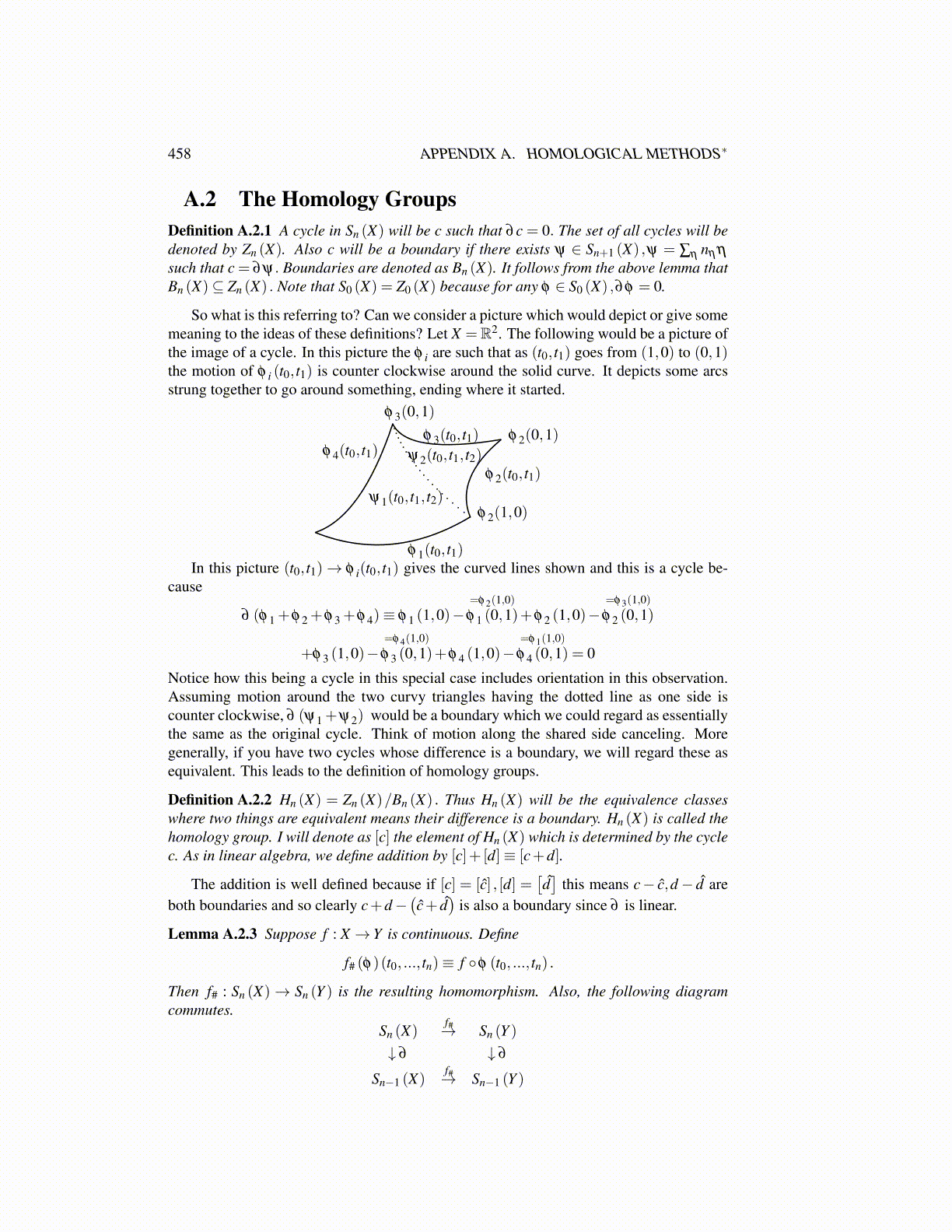
458 APPENDIX A. HOMOLOGICAL METHODS∗
A.2 The Homology GroupsDefinition A.2.1 A cycle in Sn (X) will be c such that ∂c = 0. The set of all cycles will bedenoted by Zn (X). Also c will be a boundary if there exists ψ ∈ Sn+1 (X) ,ψ = ∑η nη η
such that c = ∂ψ. Boundaries are denoted as Bn (X). It follows from the above lemma thatBn (X)⊆ Zn (X) . Note that S0 (X) = Z0 (X) because for any φ ∈ S0 (X) ,∂φ = 0.
So what is this referring to? Can we consider a picture which would depict or give somemeaning to the ideas of these definitions? Let X =R2. The following would be a picture ofthe image of a cycle. In this picture the φ i are such that as (t0, t1) goes from (1,0) to (0,1)the motion of φ i (t0, t1) is counter clockwise around the solid curve. It depicts some arcsstrung together to go around something, ending where it started.
φ 1(t0, t1)
φ 2(t0, t1)
φ 3(t0, t1)φ 4(t0, t1)
ψ1(t0, t1, t2)
ψ2(t0, t1, t2)
φ 2(1,0)
φ 2(0,1)φ 3(0,1)
In this picture (t0, t1)→ φ i(t0, t1) gives the curved lines shown and this is a cycle be-cause
∂ (φ 1 +φ 2 +φ 3 +φ 4)≡ φ 1 (1,0)−=φ2(1,0)φ 1 (0,1)+φ 2 (1,0)−
=φ3(1,0)φ 2 (0,1)
+φ 3 (1,0)−=φ4(1,0)φ 3 (0,1)+φ 4 (1,0)−
=φ1(1,0)φ 4 (0,1) = 0
Notice how this being a cycle in this special case includes orientation in this observation.Assuming motion around the two curvy triangles having the dotted line as one side iscounter clockwise, ∂ (ψ1 +ψ2) would be a boundary which we could regard as essentiallythe same as the original cycle. Think of motion along the shared side canceling. Moregenerally, if you have two cycles whose difference is a boundary, we will regard these asequivalent. This leads to the definition of homology groups.
Definition A.2.2 Hn (X) = Zn (X)/Bn (X) . Thus Hn (X) will be the equivalence classeswhere two things are equivalent means their difference is a boundary. Hn (X) is called thehomology group. I will denote as [c] the element of Hn (X) which is determined by the cyclec. As in linear algebra, we define addition by [c]+ [d]≡ [c+d].
The addition is well defined because if [c] = [ĉ] , [d] =[d̂]
this means c− ĉ,d− d̂ areboth boundaries and so clearly c+d−
(ĉ+ d̂
)is also a boundary since ∂ is linear.
Lemma A.2.3 Suppose f : X → Y is continuous. Define
f# (φ)(t0, ..., tn)≡ f ◦φ (t0, ..., tn) .
Then f# : Sn (X)→ Sn (Y ) is the resulting homomorphism. Also, the following diagramcommutes.
Sn (X)f#→ Sn (Y )
↓ ∂ ↓ ∂
Sn−1 (X)f#→ Sn−1 (Y )